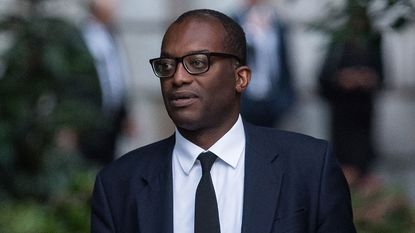The latest news on the energy price cap
The government is to bring in an “Energy Price Guarantee” to help householders with their energy costs, plus a huge package of support for businesses. Rupert Hargreaves looks at what's planned.


Last week Liz Truss announced that energy prices will be capped at £2,500 a year for a typical home for up to two years, under the government’s new Energy Price Guarantee (EPG).
The EPG will apply to the unit cost of energy, in the same way Ofgem applies (ed) its own price cap. Ofgem had set the cap at £3,549 from October for an average household, with some projections showing bills will top £6,000 next year.
The energy price cap is the maximum price per kilowatt hour (kWH) of energy, plus standing charges, that providers can charge for gas and electricity.
Subscribe to MoneyWeek
Subscribe to MoneyWeek today and get your first six magazine issues absolutely FREE

Sign up to Money Morning
Don't miss the latest investment and personal finances news, market analysis, plus money-saving tips with our free twice-daily newsletter
Don't miss the latest investment and personal finances news, market analysis, plus money-saving tips with our free twice-daily newsletter
On top of this cap, the previously announced £400 energy bill discount will still apply, and green levies costing £150 will be temporarily removed. That means the average household bill will remain stable at roughly the current level of £1,971.
While the government’s announcement is a huge development for the UK energy market, it’s worth noting that the £2,500 figure is still an average. Some homes will pay more for their energy and some will pay less.
According to the government’s numbers, this plan will save households £1,000 a year.
Unit rates under the new guarantee
The EPG will fix unit rates for domestic customers. Prices suppliers pay to buy and sell the energy will still continue to change, but the government, rather than consumers, will pay the difference.
Unlike the previously announced support packages, which left some users out in the cold (quite literally), this policy is designed to help all domestic users.
The EPG will apply to unit rates rather than standing charges. Standing charges will stay as set by Ofgem for October 2022.
The announced rates are as follows:
- Electricity: 34p per kWh with a standing charge of 46p per day
- Gas: 10.3p per kWh with a standing charge of 28p per day
Once again, these are averages. Standing charges will vary from region to region. Some parts of the UK (primarily remote regions) have seen big jumps in standing charges over the past couple of years as the cost of supplying energy has risen. Other more densely populated regions, such as London, have escaped these hikes.
As such, the only way to be sure how much you will be charged is to check and review any statements from your energy provider.
If you’re on a fixed tariff the government has said that your unit prices will be reduced by 17p/kWh for electricity and 4.2p/kWh for gas.
Excluding the impact of the government’s additional £400 energy bill discount, these figures suggest energy prices on standard variable rate tariffs will still jump by 27% in October.
There’s also no getting away from the fact that the typical household on a standard variable rate tariff will still be paying a lot more for energy this winter than they were last. Last year the price was set at 20.8p/kWh for electricity and 4.1p/kWh for gas.
Under the EPG users will be paying 1.6 times more for electricity this year than last winter, and 2.5 times more for gas.
A new energy price cap for businesses
The government is also introducing a huge package of support for businesses. Under these new plans, businesses are going to have their energy costs capped at the same price per unit or kilowatt hour (kWh) as households. That will come as a tremendous relief for business owners across the country struggling with rising energy bills.
However, while the initial plan is to cap prices for six months, the scheme will be reviewed after three to see if more targeted support is needed for individual sectors, such as hospitality and manufacturing.
This big bazooka of spending from the government could have a huge price tag. Most analysts expect the cost will come in at about £150bn, although the final figure could be much lower or much higher. It depends on where global energy prices trade over the next two years.
Truss and her team have said they’re not planning to introduce windfall taxes to pay for the spending. Instead, they’re concentrating on boosting supply and working with energy producers to lower costs.
The new PM is going to launch a new oil licensing round, potentially as early as next week with scope to grant as many as 100 new exploration licences. On top of this, a new Energy Supply Taskforce will negotiate with suppliers to agree long-term contracts with the aim of reducing the price they charge for energy.
Further, Truss announced today a £40bn liquidity facility to help energy companies deal with volatile hydrocarbon prices and stem the chances of a cash flow crisis.
Bold plans to keep a lid on prices
These are very bold plans, and we’re going to have to wait and see how much they’ll cost. The new chancellor, Kwasi Kwarteng, will set out the expected costs in a fiscal statement later this month.
But one thing is for sure: Truss has made a big splash here in her first week in office. Capping energy costs could completely change the outlook for the economy over the next two years, and ramping up spending on oil and gas exploration may change the face of energy in the UK for decades to come.
These changes will affect everything from government and business spending plans, to consumer confidence, the rate of inflation and the Bank of England’s view of further interest rate hikes.
Economists already expect the package to knock five percentage points from peak inflation, potentially saving the government as much as £25bn in interest costs this year.
SEE ALSO:
Rupert is the Deputy Digital Editor of MoneyWeek. He has been an active investor since leaving school and has always been fascinated by the world of business and investing.
His style has been heavily influenced by US investors Warren Buffett and Philip Carret. He is always looking for high-quality growth opportunities trading at a reasonable price, preferring cash generative businesses with strong balance sheets over blue-sky growth stocks.
Rupert was a freelance financial journalist for 10 years before moving to MoneyWeek, writing for several UK and international publications aimed at a range of readers, from the first timer to experienced high net wealth individuals and fund managers. During this time he had developed a deep understanding of the financial markets and the factors that influence them.
He has written for the Motley Fool, Gurufocus and ValueWalk among others. Rupert has also founded and managed several businesses, including New York-based hedge fund newsletter, Hidden Value Stocks, written over 20 ebooks and appeared as an expert commentator on the BBC World Service.
He has achieved the CFA UK Certificate in Investment Management, Chartered Institute for Securities & Investment Investment Advice Diploma and Chartered Institute for Securities & Investment Private Client Investment Advice & Management (PCIAM) qualification.
-
-
 Investment trust discounts hit 2008 levels. Here’s how to profit
Investment trust discounts hit 2008 levels. Here’s how to profitInvestment trust discounts have risen to levels not seen since 2008, here are three trusts looking to buy to profit.
By Rupert Hargreaves Published
-
 A luxury stock to buy at a high street price
A luxury stock to buy at a high street priceInvestors wrongly consider Watches of Switzerland a high-street outlet.
By Dr Matthew Partridge Published
-
 August NS&I Premium Bond winners unveiled - have you scooped £1m?
August NS&I Premium Bond winners unveiled - have you scooped £1m?Two lucky NS&I Premium Bond winners are now millionaires in the August draw. Find out here if you are one of them
By Tom Higgins Published
-
 Savings rates more than double in a year as challenger banks top the best buy tables
Savings rates more than double in a year as challenger banks top the best buy tablesThe best savings rates have doubled - and in some cases tripled - in a year, with challenger banks offering the highest rates. While they are still no match for inflation, we look at what you could be earning.
By Ruth Emery Published
-
 Midlife MOT: what is it and who can get one?
Midlife MOT: what is it and who can get one?The government has launched an online midlife MOT to help older workers with financial planning, health guidance and career skills. But how does it work, who can get one and would you pass it?
By Ruth Emery Published
-
 Coventry Building Society launches new best easy access savings account
Coventry Building Society launches new best easy access savings accountCoventry Building Society's deal tops our easy access savings account list, but could your cash be put to better use?
By Tom Higgins Published
-
 NS&I boosts fixed-term savings rates
NS&I boosts fixed-term savings ratesThe NS&I, the government-backed savings institution has mirrored recent rate rises seen elsewhere in the market.
By Tom Higgins Published
-
 Should you let AI give you financial advice?
Should you let AI give you financial advice?Can AI fill the financial advice gap? Kalpana Fitzpatrick looks at the pros and cons of using AI to guide your finances.
By Kalpana Fitzpatrick Published
-
 Small pension pots to be consolidated, says DWP
Small pension pots to be consolidated, says DWPWorkplace pension schemes worth less than £1,000 that become “deferred” when a saver changes jobs will be consolidated under a new system
By Ruth Emery Published
-
 Watchdog summons banks to explain paltry savings rates
Watchdog summons banks to explain paltry savings ratesSavings rates trail mortgage rates - and the financial watchdog has summoned banks to a meeting amid concerns of profiteering.
By Katie Binns Last updated









